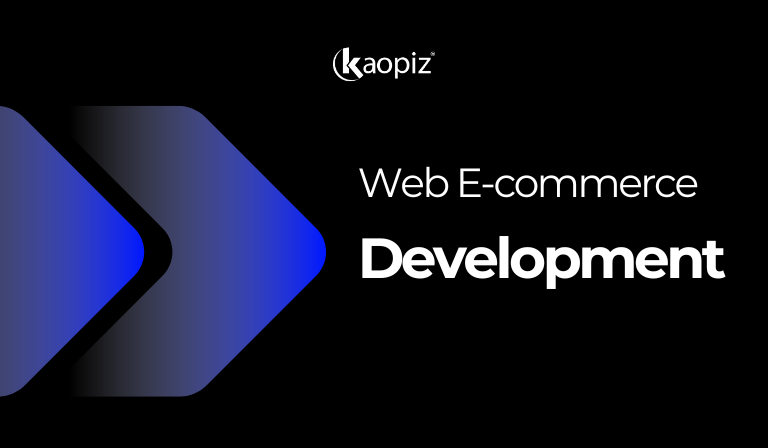What is API? | Simple explanation of API mechanism and benefits
Interacting with computers, apps and websites requires user interface (UI) components with menus and graphical elements, keyboards, mice and other inputs.
On the other hand, software or its components do not require a graphical user interface to communicate with each other.
If you’ve read tech magazines or blogs, you’ve probably seen the acronym API. What does this represent? API stands for Application Programming Interface. This article will explain what an API is, how an API works, and why you should pay attention to APIs in the first place.
Table of Contents
- What is API?
- API Features
- API Mechanism
- API Benefits
- API Types
- How API Works
- API Protocols
- Latest API Trends
- Explore APIs with Kaopiz’s expertise
What is API?
API stands for Application Programming Interface. It is the intermediary that enables two applications to communicate with each other. API is a convenient way to extract and share data within and between companies.

When using the above apps, your phone connects to the internet and sends data to servers. The servers fetch and interpret that data, take any necessary actions, and send back responses to your phone. The app interprets the data and displays the information you wanted in a readable format.
When using the above apps, your phone connects to the internet and sends data to servers. The servers fetch and interpret that data, take any necessary actions, and send back responses to your phone. The app interprets the data and displays the information you wanted in a readable format.
Learn more What is an API at: Link
API Features
While the term “API” has historically referred to application interface connections, modern APIs have unique features that have truly transformed the technical landscape. First, modern APIs adhere to specific standards, usually HTTP and REST. This makes APIs developer-friendly, self-descriptive, easy to use, and widely understood.
Modern developers treat APIs more like products than code. They design APIs for specific users (e.g., mobile developers), document and version them to help users anticipate maintenance and lifecycles, and actively monitor and manage their performance and scale. Most importantly, developers have greatly enhanced the security and governance provisions of APIs. In practical terms, when you use a weather app API, it doesn’t fully expose your phone data to a server.
Finally, like other software products, modern APIs have their own software development lifecycles (SDLC) – from mockup to design, testing, building, management, and deprecation. APIs are sufficiently documented for consumption and versioning as part
API Mechanism
To understand how APIs work, it helps to look at a common example like third-party payment processing. When a user makes a purchase on an online shop, they may be prompted to “Pay with PayPal” or another third-party system type. This functionality relies on APIs to make the connection.

When the purchaser clicks the payment button, the API makes a call to fetch information. This is known as a request. The request gets handled by the web server via the API’s Uniform Resource Identifier (URI) from the application. Requests can contain request.verb, headers, and sometimes request bodies.
After receiving a valid request from the product webpage, the API makes a call out to an external program or web server (in this case the third-party payment system).
The server sends a response back to the API containing the requested information.
The API passes the data to the original requesting application (here the product website).
How the data gets transferred varies by web service used, but requests and responses all go through the API. This is invisible on the user interface. That is, the API is exchanging data within computer and app backends and looks like a seamless connection to the user.
API Benefits
APIs simplify the design, development, integration and management of new applications and services, as well as the integration and management of existing applications and services. But they provide additional major benefits for developers and organizations as a whole:
Enhanced Collaboration
The average enterprise uses close to 1,200 cloud apps, many of which are siloed. APIs integrate them so platforms and apps can communicate seamlessly. This integration helps companies automate workflows and enhance collaboration in the workplace. Without APIs, many enterprises would lack connectivity and suffer from the information silos that hamper productivity and performance.
Accelerated Innovation
The flexibility APIs provide allows companies to build connections with new business partners, bring new services to existing markets, and ultimately enter entirely new markets that can generate tremendous revenue and drive digital transformation. For example, Stripe began with a 7-line API code. It has since partnered with many of the world’s largest enterprises, expanded into offerings like lending and corporate cards, and recently garnered a $36 billion valuation.
Monetization of Data
Many companies initially choose to offer their APIs for free. Doing so builds an audience of developers around their brand and incubates relationships with potential business partners. When APIs enable access to valuable digital assets, companies can monetize that access. This is known as the API economy. When AccuWeather launched a self-serve developer portal to sell a range of API packages, it attracted 24,000 developers and sold 11,000 API keys in just 10 months, while fostering an active community.
System Security
APIs separate the infrastructure of the requesting app and responding service, providing a security layer as they communicate. For example, API calls typically require authentication credentials. HTTP headers and cookies provide additional security during data exchange, and API gateways can further control access to minimize security threats.
End-User Security and Privacy
Just as APIs strengthen protection within a network, they can provide additional layers of protection for individual users. When a website requests user location data via a location API, the user gets to decide whether to allow or deny that request. Many web browsers and mobile operating systems like iOS have permission structures built in for when APIs request access to apps and their data. If an app needs to access files via APIs, the file systems in Windows, Mac, Linux, etc. use permissions to control that access.
API Types
Today most APIs expose application data and functionality on the internet as web APIs. Here are the four main types of web APIs:

Open APIs are open-source application programming interfaces that are accessible via HTTP protocol. Also known as public APIs, they define API endpoints and request and response formats.
Partner APIs connect strategic business partners. Developers typically access these in self-service mode through a public developer portal. But developers still have to complete an onboarding process and obtain login credentials for accessing Partner APIs.
Internal APIs remain hidden from external users. These private APIs are not available to outside users. Instead, they aim to improve productivity and communication between different internal development teams within a company.
Composite APIs combine multiple data APIs and service APIs into a single API. This enables programmers to access multiple endpoints with a single call. Composite APIs are useful in microservices architectures where a single task may require information from multiple sources.
How API Works
APIs function through a request-response process. When an application (client) needs data or action from another application (server), it sends a request through the API. The server processes the request and returns the required information or performs the action, which the client then uses to deliver a final output.
By enabling access to their resources while maintaining security and control, APIs have become a vital part of both business and consumer applications today. Here are some common examples of APIs that users encounter almost daily:
Universal Login
A commonly used API example is the ability to log into websites using your login credentials from Facebook, X (Twitter), Google profiles, etc. This convenient feature allows quick authentication via popular services’ APIs on any website, saving users the time and hassle of setting up new profiles each time they access a web application or sign up for an account.
IoT (Internet of Things)
“Smart devices” provide additional internet-enabled capabilities like touchscreens and data collection through APIs. For example, a smart refrigerator can connect to recipe apps and send texts to your phone to jot down notes or reminders. Its built-in camera can connect to various apps so you can see inside your fridge from anywhere.
Travel Reservation Comparison
Travel booking sites aggregate thousands of flights and introduce you to the lowest priced options for any date and destination. This service is possible because APIs provide access to the latest availability data from hotels, airlines, and booking companies’ own apps to users via their web browser or travel booking app. By automating data exchange and requests, APIs dramatically reduce the time and effort spent checking flight and lodging availability.
Mapping Apps
Mapping apps rely on a core API to display static or interactive maps, as well as various APIs and capabilities to alert users about directions, speed limits, points of interest, traffic warnings, and more. Users communicate with APIs when displaying routes or tracking moving items like delivery vehicles.
For example, Google Maps API: Many apps and websites integrate Google Maps for navigation, location data, and directions using Google’s Maps API.
Every tweet contains descriptive core attributes like the tweeter, unique ID, message, and timestamp. Twitter makes the core attributes of public tweets and replies available for developers to consume via their APIs, enabling developers to post tweets into other web pages.
SaaS Applications
APIs are an essential element in the growth of SaaS (Software-as-a-Service) products. Platforms like CRM (customer relationship management tools) contain many built-in APIs that let companies integrate with messaging, social media, email apps and more that they already use. This saves significant time switching between applications for sales, marketing, and other tasks. It also helps reduce or prevent potential data silos that can exist between departments using different applications.
API Protocols
As the use of web APIs grew, specific protocols were developed and used to provide defined sets of rules (i.e. specifications) for creating the data formats, commands, and syntax to build APIs. In fact, these API protocols have facilitated standardized information exchange.

SOAP (Simple Object Access Protocol)
SOAP is built on XML and enables endpoints to send and receive data via SMTP or HTTP.
This type of APIs facilitate information sharing between applications or software components running in different environments or written in different languages.
XML-RPC (XML Remote Procedure Call)
The XML-RPC protocol relies on a specific XML format to transfer data. XML-RPC is older than SOAP but simpler, and relatively lightweight since it uses minimal bandwidth.
JSON-RPC
Like XML-RPC, JSON-RPC is a remote procedure call but uses JSON (JavaScript Object Notation) instead of XML to transfer data.
REST (Representational State Transfer)
REST refers to a set of principles for web API architecture. A REST API (also called RESTful API) is an API that adheres to specific REST architectural constraints. We can use SOAP protocols to build RESTful APIs, but these two standards are usually seen as competing specifications.
Latest API Trends
As the digital landscape evolves, new trends in API technology are emerging:
- Asynchronous APIs: Unlike traditional synchronous APIs, asynchronous APIs allow applications to send requests and receive responses without waiting, which improves performance and user experience, especially in high-demand applications.
- APIs in IoT (Internet of Things): APIs are essential in IoT, enabling devices to communicate and share data. From smart home devices to connected vehicles, IoT APIs are driving innovation in automation and connectivity.
- GraphQL Adoption: GraphQL is gaining popularity for its flexibility and efficiency, particularly in applications with complex data structures, as it allows for precise data requests.
- Security and Compliance-Focused APIs: As data privacy concerns grow, APIs are being designed with enhanced security and compliance features, like encryption and authentication, to protect sensitive data.
Explore APIs with Kaopiz’s expertise
While APIs originally referred to interfaces connected to applications written in lower level programming languages like JavaScript, modern APIs typically conform to REST principles and JSON formats. These are commonly built for HTTP, easily accessible from applications written in Java, Ruby, Python, and more, providing widely understood, developer-friendly interfaces.
Keeping up with these trends helps developers and businesses stay competitive and ensures that API-driven applications remain effective and secure.
If your company wants to build software and needs API advice but has a limited budget and wants to consider offshore development, contact Kaopiz. We are a Vietnam-based software development company providing high-level services for cost, speed, and quality. Those looking for a software development company, please feel free to inquire with us.
See the Japanese version of this article here: LINK
9 Replies to “What is API? | Simple explanation of API mechanism and benefits”
Leave a Comment
Trending Post





















Pingback:Top 10 Web Development Trends in 2025: Boost Speed & Security
Pingback:AI Integration in Business: Benefits, Strategies, & Applications
Pingback:Best AI Chatbots for Business in 2025: How to Choose Right One
Pingback:10 Finance AI Chatbots in 2025: Benefits, Use Cases, & Solutions
Pingback:5 Data Warehouse Examples: From Cloud to Real-Time Solutions
Pingback:10 Digital Transformation Trends in Singapore (2025): What Businesses Need to Know
Pingback:Agentic AI: The Next Leap in AI Automation for Singapore (2025)
Pingback:Top 10 Fastest Programming Languages in Singapore [2025 Guide]
Pingback:Healthcare App Development: Cost, Process, Partner Guide 2025